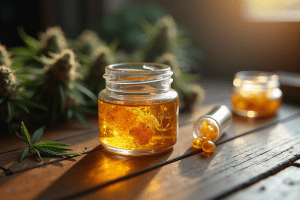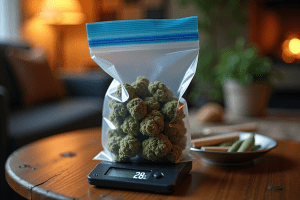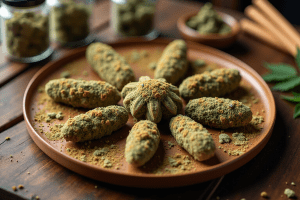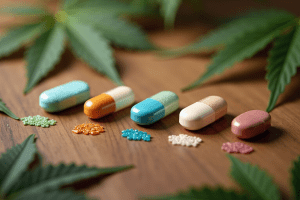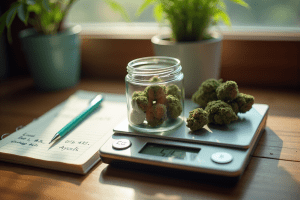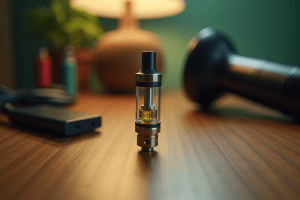Our ultimate guide for making pot brownies, cannabutter, and where to find the best edibles within the cannabis market.
What are edibles?
Edible cannabis products contain cannabinoids that you can consume by eating or drinking. Cannabinoids are chemical compounds found in cannabis that can affect your mind and body after consumption. THC (tetrahydrocannabinol) is a cannabinoid that makes an individual feel high.
Benefits of Consuming Edibles Over Other Methods
Edibles offer distinct advantages compared to smoking or vaping cannabis. Since they are ingested rather than inhaled, they eliminate exposure to smoke, making them a lung-friendly option.
Another key benefit is their longevity. While smoking or vaping may deliver effects that last a few hours, edibles can produce effects that last six hours or more—ideal for those seeking longer-lasting relief.
Making edibles at home also gives you greater control. You can adjust potency, select quality ingredients, and cater to dietary preferences like vegan or gluten-free. This level of customization isn’t always possible with store-bought products or other consumption methods.
Understanding Marijuana Brownies and Their Origins
Marijuana brownies are a popular edible form of cannabis, creatively blending the effects of THC with the indulgent taste of chocolate. These treats are a discreet and tasty way for users to consume cannabis, often preferred by those seeking alternatives to smoking.
Origins of Marijuana Brownies
The concept of infusing brownies with cannabis traces back several decades. They gained particular fame in the 1980s through the efforts of Mary Jane Rathburn, affectionately dubbed “Brownie Mary.” She became well-known for distributing cannabis-infused brownies to AIDS patients, advocating for both the medicinal benefits of cannabis and the compassion behind her actions. Her pioneering work helped pave the way for the broader acceptance and legalization of cannabis edibles that we see today.
Whether for recreational or medicinal purposes, marijuana brownies continue to be a favored choice for consumers who appreciate their flavorful disguise and potent effects.
How do they work?
Edibles are consumed and digested, encouraging the body’s endocannabinoid system (ECS) to do its job. The endocannabinoid system is comprised of an extensive network of chemical signals and cellular receptors densely packed throughout our brains and bodies.
The “cannabinoid” receptors in the brain — the CB1 receptors — outnumber many of the other receptor types in the brain. They regulate the body through immediate feedback, turning up or down the movement of whichever system needs to be adjusted, whether hunger, temperature, or alertness. Our bodies produce molecules called endocannabinoids to stimulate these receptors, which have a structural similarity to molecules in the cannabis plant.
The endocannabinoid system regulates and controls learning and memory, emotional processing, sleep, temperature control, pain control, inflammatory and immune responses, and eating. This vital system is currently at the center of renewed international research and drug development.
Edible Dosage
When trying edibles for their medicinal properties, begin with a low dose, then increase the dose depending on comfort levels. If you’re unsatisfied with the desired effects after the first use, you can exponentially increase the dose. You can also boost your dosage of cannabis products slowly over a few weeks to reduce discomfort and ensure safe cannabis consumption.
To make your cannabis brownies stronger, focus on increasing the potency of the infused ingredients. Here are some methods:
- Use More Cannabis Flower: Opt for a more potent strain when infusing your canna-oil or cannabutter. This allows for a higher concentration of THC without simply adding more oil or butter.
- Incorporate THC Distillate: This potent cannabis extract can significantly enhance the strength of your brownies. Just ensure you adjust the dosage to suit your comfort level.
By combining these techniques, you can tailor the potency of your edibles while maintaining control over your experience. Remember, patience and careful adjustment are key to finding the right balance.
How to Calculate THC Content in Weed Brownies
Wondering how strong your homemade cannabis brownies really are? Estimating the THC content is simpler than you think. Here’s how to do it:
Start by checking the THC percentage of your cannabis strain—this is usually listed on the label or product packaging. Then, multiply the amount of cannabis you’re using (in milligrams) by the THC percentage. For example, if you’re using 500 mg (or 0.5 grams) of cannabis with 20% THC, your total batch will contain about 100 mg of THC (500 mg × 0.20 = 100 mg).
To estimate the dose per brownie, divide that total amount by the number of servings. If you slice the batch into 10 brownies, each one would have approximately 10 mg of THC.
Keep in mind, some potency is always lost during decarbing, infusion, and baking. The final result will be a little less than the calculation, but this method still gives a reliable starting point for safe, consistent dosing.
The Importance of Precise Measurement in Cannabis Edibles
When it comes to baking with cannabis, precision matters. Even a small difference in the amount of cannabis you use can significantly change the potency of your final product.
Standard kitchen scales often aren’t accurate enough for edibles. Many can’t distinguish between 0.5 grams and 1 gram—which might not seem like much, but can double the strength of your batch. That’s why a digital scale that measures down to a tenth of a gram is essential for accurate dosing.
Using a precise scale helps you:
- Properly measure your cannabis for consistent potency in canna-oil or cannabutter
- Prevent unintentional over- or under-dosing, especially in small batches
- Experiment with strengths safely, knowing exactly how much THC you’re working with
Taking this extra step gives you more control over your experience, ensuring every batch of edibles is predictable, safe, and enjoyable.
Easy Pot Brownie Recipe
Looking for a quick and straightforward way to make pot brownies? This recipe transforms a standard boxed brownie mix into a cannabis-infused delight.
Ingredients
- One Box of Brownie Mix (we recommend the Ghirardelli brand)
- ¼ cup Canna Oil
- Additional ingredients per the box of brownie mix (eggs, water, vanilla)
Instructions
- Prepare the Mix: Follow the instructions on the box to make brownies. Preheat your oven as directed.
- Infuse with Canna Oil: Replace ¼ cup of vegetable oil with Canna Oil for that special twist.
- Bake the Brownies: Pour the prepared mix into a greased baking pan. Follow the box instructions for baking time and temperature.
- Cool and Serve: Once baked, let the brownies cool before serving. Enjoy your delicious treats!
How to Control Dosage and Ingredients in Homemade Edibles
One of the biggest benefits of making cannabis edibles at home is control. You can adjust both the ingredients and potency to match your preferences and dietary needs.
Start with a low THC dosage, especially if you’re new to edibles. Increase gradually over time as you get used to the effects. Use high-quality cannabis flower or THC distillate and measure carefully during infusion to create a consistent product.
Homemade edibles also give you complete control over the ingredients, allowing you to use organic sweeteners, gluten-free flours, or plant-based alternatives to suit your lifestyle. Whether you’re using cannabutter or canna-oil, you get to decide what goes in and how strong it is.
Cutting Brownies for Consistent Dosing
Once your cannabis brownies are baked, how you slice them matters just as much as how you made them. Even portions help ensure each serving delivers a predictable dose of THC.
Using a ruler or sharp knife, cut your 8×8-inch pan into equal squares based on the total THC in your batch. Here’s a general guide using cannabis with 20% THC (500 mg of flower = ~100 mg total THC):
- 12 pieces: about 8 mg THC per brownie – a common moderate dose
- 16 pieces: around 6 mg THC per brownie – great for lighter effects
- 9 pieces: roughly 11 mg THC – for experienced users
- 32 mini bites: ~3 mg THC per piece – ideal for beginners
If you’re new to edibles, start with a smaller portion and wait at least 1 to 2 hours before considering another. Cannabis edibles can take time to fully kick in, and patience is essential for a comfortable experience.
The Importance of Accurate Temperature Control
Temperature plays a major role in the success of cannabis edibles. Even a small variation can affect both the strength and flavor of your final product.
Start by using an oven thermometer when decarboxylating your cannabis. Many ovens run hotter or cooler than their settings suggest, and getting the temperature just right—around 240°F—is key to activating THC without burning it.
When infusing butter or oil, an instant-read thermometer can help you maintain a steady temperature below 190°F. Staying within this range prevents the cannabinoids from breaking down and ensures the infusion is smooth and effective.
With these tools, you can feel confident your weed brownies will turn out just as you intended—potent, flavorful, and consistent every time.
Homemade Pot Brownie Recipe
For those who prefer a more hands-on approach, these Double Chocolate Weed Brownies are a delectable choice. They’re rich, fudgy, and infused with cannabis for a homemade touch.
Ingredients
- 1/4 cup natural cocoa powder, plus more for the pan
- Cannabutter (1/2 cup unsalted butter and gram of weed)
- 1/2 cup chopped dark chocolate
- 1 1/4 cups granulated sugar
- One tablespoon molasses
- One teaspoon of vanilla extract
- 1/4 teaspoon kosher salt
- 1/2 tablespoon baking powder
- Two large eggs
- 3/4 cup all-purpose flour
- 1/2 cup chopped toasted nuts (optional)
- A handful of chocolate chips (optional)
Directions
- Prepare the Pan: Butter an 8×8-inch baking pan, then dust with cocoa powder. Preheat your oven to 350°F (175°C) to ensure even baking.
- Melt and Mix: In a heatproof bowl, melt the cannabutter and dark chocolate together. Once smooth, remove from heat and add the sugar, molasses, vanilla, and salt.
- Combine Ingredients: Add the eggs one at a time, mixing thoroughly after each. Beat for about 5 minutes until a ribbon forms on the surface when you lift the whisk. Stir in the optional nuts for added texture. If you’re allergic to nuts or simply not a fan, you can easily swap in ⅔ cup semisweet or bittersweet chocolate chips or chunks instead.
- Incorporate Dry Ingredients: Sift or whisk the flour with the cocoa powder, then gently fold into the chocolate mixture until just combined.
- Bake: Pour the batter into the prepared pan, smoothing the top. Bake for about 25 minutes, keeping an eye on the edges as they firm up. Use a toothpick near the corner to check for doneness.
- Cool and Store: Allow the brownies to cool on a wire rack for at least 10 minutes before cutting into 16 squares. Store in an airtight container for up to a week, or freeze for longer storage. Reheat before serving for best flavor.
Both recipes offer a delightful way to enjoy cannabis brownies, catering to different levels of baking expertise and time commitments.
Vegan Weed Brownie Recipe
Making vegan weed brownies is simple and satisfying. This dairy-free recipe uses vegan cannabutter to deliver rich, fudgy brownies without compromising on flavor.
Ingredients
- 1/2 cup melted vegan cannabutter
- 1 1/2 cups granulated sugar
- 1/3 cup unsweetened non-dairy milk (such as oat, almond, or coconut)
- 2 teaspoons vanilla extract
- 1 cup all-purpose flour
- 3/4 cup unsweetened cocoa powder
- 3/4 teaspoon baking powder
- 1/2 teaspoon salt
- 1 cup vegan chocolate chips
Instructions
1. Prep the Pan
Preheat your oven to 350°F (175°C). Grease the bottom and sides of an 8×8-inch pan with vegan butter, then line it with parchment paper. Lightly grease the parchment as well.
2. Mix Wet Ingredients
In a large bowl, whisk the melted vegan cannabutter and sugar together. Stir in the non-dairy milk and vanilla until fully combined.
3. Combine Dry Ingredients
In a separate bowl, whisk the flour, cocoa powder, baking powder, and salt to remove any lumps.
4. Mix Batter
Add the dry mixture to the wet ingredients and stir gently until just combined. Avoid overmixing.
5. Add Chocolate
Fold in the vegan chocolate chips.
6. Bake
Spread the batter evenly in the prepared pan. Bake for about 25 minutes or until a toothpick inserted near the center comes out with a few moist crumbs.
7. Cool and Slice
Let the brownies cool completely in the pan before cutting into squares.
Baking and Storing Vegan Weed Brownies
Bake your vegan weed brownies at 350°F for about 25 minutes. To keep a soft, gooey center with firm edges, avoid overbaking. Start checking for doneness around the 22-minute mark by inserting a toothpick near the edge—aim for a few moist crumbs, not raw batter.
After baking, let the brownies cool in the pan for at least 10 minutes. This helps them set and makes slicing cleaner and easier.
Store leftovers in an airtight container at room temperature for up to a week. For longer storage, freeze them and reheat gently when ready to enjoy again.
Steps for Making Cannabutter
Here, we provide a detailed guide with all the steps to make a delicious, potent cannabis butter for making weed brownies.
Use High-Quality Cannabis Flowers
The quality of your cannabis flower is essential. It can affect the potency and flavor of your finished weed oil. It’s crucial to find a high-quality strain with the desired effects you’re looking to feel. Pairing potent, decarbed cannabis with good quality butter is an excellent way to ensure that you have the best cannabutter for your pot brownies recipe.
Preheat Your Flower
In raw form, marijuana has no psychoactive potential. Natural cannabis and its derivatives contain cannabinoids THCA and CBDA. When you eliminate A, you’ll find THC and CBD. Without activation, this drug does not cause any psychoactive effects.
Decarb Process
The cannabis plant is organically non-psychedelic. This plant material contains high amounts of cannabinoids such as THCAs and CBDA, which form a broad range of cannabinoid acids. To achieve the ‘high’ effect of marijuana, you will have to convert the cannabis through decarboxylation.
Cannabutter is primarily made by decarboxylating cannabis flowers and can be made using various techniques for the infusion process. The cannabinoids that live within cannabis flowers are activated when they are decarboxylated or removed.
Baking
If you’re planning to make infused butter, baking your weed first is an optimal way to decarb. You’ll want to break up your buds into small pieces and evenly distribute them on a sheet pan with parchment paper. Then, you’ll cover and bake on low heat for thirty minutes. After it cools, you’ll have fully decarbed cannabis for your edibles.
Boiling
You can also boil cannabis in a tea bag or place it in a heatproof bowl of simmering water to draw out the cannabinoids. Once the cannabis has reached the ideal temperature, you can add melted butter to provide something the cannabinoids can stick to.
Double Boiler Infusion Method
For a gentle, even infusion, the double boiler technique is a popular choice, especially if you want to avoid scorching your cannabis or butter.
To get started, fill a medium saucepan with a couple of inches of water and bring it to a gentle simmer over medium-low heat. Set a heatproof bowl (like glass or stainless steel) on top, ensuring it doesn’t touch the water directly.
Add your desired amount of butter (unsalted works best for most recipes) and a splash of water to the bowl. Once the butter melts, gently crumble your decarbed cannabis flower into the mixture. Stir to combine, then adjust the heat so the temperature of your butter stays below 190°F—use an instant-read thermometer for accuracy.
Let this mixture infuse on low heat for up to an hour, checking the temperature occasionally and stirring every so often. The slow, gentle heat helps extract cannabinoids without burning off the beneficial compounds.
Once infused, you’ll be ready to strain and use your cannabutter in your favorite treats.
Pick Your Fat or Butter
Regular butter is a type of fat used in a cooking experiment for cannabis and has an ideal consistency and flavor and should be included in many baking recipes. Based on how you plan on using this fat, you could add some additional ingredients.
Olive oil, vegetable oil, and coconut oil, all fatty acids that can remain stable in the liquid between 160-200 degrees, can be used to infuse the butter.
Why Make Cannabis-Infused Treats Without Animal By-Products
Choosing to make cannabis edibles without animal by-products offers flexibility, inclusivity, and control. Vegan cannabutter, made with coconut oil, olive oil, or other plant-based fats, is an effective carrier for cannabinoids and can be used in most recipes.
This plant-based approach supports dietary preferences, accommodates food allergies, and makes your treats accessible to a wider group of people. It also gives you better control over what goes into your edibles, from the fat source to the final flavor.
Steep Away
It is possible to soak decarbed grass with fat by following several techniques. Probably the most basic version occurs over the stove using one or two large pots. To make a batch of cannabutter, mix the butter in equal parts of water. The process aims to keep the temperature within 160 to 220 degrees, so be proactive in piloting your newly brewed beer from the start to the end.
Strain the Butter
After simmering and slowly increasing the butter’s temperature, you need to strain it. Put a few layers of cheesecloth into jars and utilize an elastic band to keep it safe during tension. You can do the same process with a coffee filter if you don’t have access to a cheesecloth. When strained, it can easily be removed or recycled into compost, and the butter can go into a mason jar. Then, placing it in a mason jar for a few hours in the refrigerator will complete the process.
Storage
You can use the cannabutter immediately to make baked goods and many recipes involving cannabis. Infused butter and fats last up to six months in the refrigerator and up to a year in the freezer when appropriately stored in mason jars or other sealed glass containers.
What is Canna-Oil and How is It Made?
Canna-oil is a versatile ingredient that mirrors cannabutter, but uses oil as the base instead of butter. It’s crafted by merging cannabis with a cooking oil, such as coconut or olive oil. This combination undergoes a process called decarboxylation which, alongside slow cooking, helps the cannabis compounds bind with the fat present in the oil.
Making Canna-Oil:
- Choose Your Oil: Select your preferred cooking oil. Coconut oil and olive oil are popular choices due to their high-fat content, which allows for effective absorption of cannabinoids.
- Prepare the Cannabis: Begin by grinding your cannabis to increase the surface area for the infusion process.
- Decarboxylation: Heat the ground cannabis in an oven to activate the THC and CBD. This step is essential for unlocking the psychoactive properties of the cannabis.
- Infusion: Mix the decarboxylated cannabis with your chosen oil. Simmer the mixture on low heat for several hours. This allows the cannabinoids to bind with the oil’s fats effectively. If you’re short on time, a quicker infusion—about an hour—will still extract most of the cannabinoids while keeping the flavor mellow. This efficient method means you can prepare your canna-oil and be ready to bake infused treats all in the same day, making the most of both your time and ingredients.
- Strain and Store: Filter out the plant material using a fine strainer or cheesecloth. Store the resulting canna-oil in a cool, dark place to preserve its potency.
Canna-oil can be used in a variety of recipes, making it a popular choice for those who enjoy culinary adventures with cannabis.
Choosing the Right Strains and Infused Ingredients for Weed Brownies
Cannabis strains are considered to be a pure or hybrid genetic variation of the plant Genus Cannabis. There are three species: Cannabis Sativa, Cannabis Indica, and Cannabis Ruderalis. Ruderalis is not as popularly known; however, it is a derivative of cannabis with the lowest THC levels. Although they are popular among the cannabis community, hybrids are not considered a species as they are made of Sativa and Indica, with typically one or the other dominating the gene pool.
Those within the cannabis community report that there are close to eight hundred unique weed strains worldwide, but that number has increased steadily throughout the years. Different strains are created yearly as botanists experiment with crossing classic marijuana strains with hybrids to change their genetic qualities.
Selecting Your Cannabis-Infused Ingredient
Once you’ve chosen your preferred strain, it’s time to select the cannabis-infused ingredient for your brownies. Here are three popular options:
- Cannabutter
Cannabutter is a classic choice for both savory and sweet recipes, including brownies. To make cannabutter, decarboxylate cannabis flower to activate the THC, then simmer it with traditional or vegan butter to infuse the cannabinoids. This process ensures the psychoactive effects are preserved. - Canna-Oil
If you prefer using oil, canna-oil is a great alternative. This involves infusing coconut oil, olive oil, or other cooking oils with cannabis. Similar to cannabutter, it requires decarboxylation and slow cooking to bind the cannabinoids with the fat in the oil, providing a versatile option for various recipes. - THC Distillate
For those seeking potency without altering taste, THC distillate is an excellent choice. It’s a concentrated form of THC that is flavorless and odorless, making it easy to incorporate into your brownies. When deciding between full-spectrum vs distillate edibles, consider their different effects and benefits to tailor your experience.
By understanding both the strain and the infusion method, you can create a personalized cannabis brownie experience that suits your taste and desired effects.
How to Choose the Right Strain for Brownies
With so many strains available at dispensaries, it can feel overwhelming to pick the right one. While general categories like sativa (uplifting) and indica (relaxing) can offer some guidance, your personal experience will depend on many factors, including your body chemistry, tolerance, and even what you’ve eaten that day. If you’re unsure where to start, talk to your local dispensary staff. Let them know you’re planning to make cannabis brownies and describe the kind of effect you’re hoping to achieve—whether it’s mellow relaxation, creative focus, or restful sleep. Their strain recommendations can help you create a batch that matches your goals.
Tailoring Your Brownie Experience
By understanding both the strain and the infusion method, you can create a personalized cannabis brownie experience that suits your taste and desired effects. Experimenting with different strains, infusion bases, and dosages allows you to fine-tune your brownies for the perfect balance of flavor and effect, whether you’re seeking a creative boost, deep relaxation, or something in between.
Skunk No. 1
- Skunk No. 1 originated in California and later was brought to the Netherlands.
- It has 17 percent THC and 1 percent CBD
- Its parent strains are Afghani, Acapulco Gold, and Colombian Gold
- It is a balanced Hybrid breed
- The flavor aroma is overwhelming and skunky with a hint of tobacco aspects
- It has an average of nine weeks of flowering time indoors
- This marijuana is used to treat depression, anxiety, and appetite loss
- It produces an uplifting, creative cerebral high that leaves you relaxed and hungry
Blue Dream
- Blue Dream originated in California, on the West Coast
- It has 18 percent THC and low CBD
- It’s a cross of Blueberry and Haze
- Blue Dream is a Sativa dominant hybrid strain
- Flavor and aroma boast sweet berries
- It has an average of 65 days of flowering time
- This strain is used to treat nausea, depression, chronic pain
- Blue Dream produces a relaxing, body high, and balanced cerebral stimulation
Island Sweet Skunk
- Island Sweet Skunk was first bred at Federation Seed Company in Canada
- It has 18 percent THC and one percent CBD content
- It’s a cross between Skunk No. 1 and Sweet Pink Grapefruit
- It’s a popular classic Sativa strain
- It smells sweet and skunky with a slight grapefruit taste
- The average flowering time indoors is seven to eight weeks long
- It’s used to treat anxiety, inflammation, and muscle spasms
- It produces an uplifting, energetic, and creative high
Girl Scout Cookies
- Girl Scout Cookies originated in the Bay Area of California
- It has 19 percent THC and 1 percent CBD
- Its parent strains are OG Kush and Durban Poison
- It is an Indica dominant hybrid breed
- The flavor is sweet and minty with an aroma of vanilla
- It has an average of ten weeks of flowering time indoors to reach the prime age
- This cake strain is used to treat muscle spasms, nausea, appetite loss, and depression
- Users say it produces a happy, cerebral high, leaving you pain-free and euphoric
Understanding THC Distillate and Its Unique Qualities
What is THC Distillate?
THC distillate is a refined and concentrated form of THC (tetrahydrocannabinol), the primary psychoactive component in cannabis. Unlike raw cannabis, distillates are distilled through a process that removes impurities and unwanted compounds, resulting in a pure, potent product. Its lack of flavor and odor makes it a versatile ingredient for a variety of applications, particularly in culinary creations such as edibles, where its presence is almost undetectable.
Key Characteristics:
- Purity: THC distillate is stripped down to its concentrated essence, offering a higher THC percentage compared to other cannabis products.
- Neutral Flavor and Aroma: Unlike other cannabis derivatives, it doesn’t carry the characteristic earthy smell or taste, allowing for seamless integration into foods and beverages.
- Versatility: Due to its neutral properties, it’s especially desirable for those looking to create discreet edibles or infusions without altering the original flavor profile of their recipes.
How THC Distillate Differs from Other Cannabis Ingredients:
- Full Spectrum vs. Distillate:
- Full Spectrum Products retain a range of cannabinoids, terpenes, and flavonoids found in the cannabis plant. These elements are thought to work together to produce the “entourage effect,” potentially enhancing therapeutic benefits.
- Distillate, on the other hand, primarily contains THC, with minimal other cannabinoids or terpenes. This leads to a more intense effect, as it highlights THC in isolation.
- Terpene Presence:
- While cannabis oils and full-spectrum extracts maintain their natural terpene content, contributing to flavor and aroma, THC distillate undergoes extensive refinement to remove these elements.
- Usage Flexibility:
- THC distillate is known for its adaptability, allowing consumers to accurately measure doses for edibles, tinctures, or vape products. Its odorless and tasteless nature provides an ideal solution for those seeking a potent experience without sensory distractions.
When considering THC distillate, it’s essential to weigh its potency and purity against the comprehensive experience offered by full-spectrum and terpene-rich formulations. Each serves a different purpose, catering to varying consumer preferences and desired effects.
Tips for Making the Best Marijuana Brownies
- Decarb before adding ground cannabis flower. If you don’t, the vegan butter will not taste ideal, and it will be less potent because the cannabinoids do not have time to be fully activated. Low heat is the way to go with this process for the best marijuana and the most delicious recipes.
- Get the grind right. It’s suggested to use a hand grinder or coarse coffee grinder for optimum results when grinding your hemp.
- Be patient when straining the cannabis oil. A cheesecloth, gravity, and time are the three ingredients needed to strain your marijuana-infused butter properly. Do not squeeze the cloth at the risk of adding in excess plant matter.
- Mix the batch well. Remember to occasionally stir when making vegan baked goods and such products with this cannabutter recipe for an even level of THC potency and flavors.
Creating marijuana brownies is fun and rewarding, providing an excellent opportunity to experiment with both recipes and dosages to find your perfect balance. Start with a base recipe and adjust the amount of cannabis-infused butter to see how it affects potency and flavor.
Consider using a variety of brownie recipes—whether classic, vegan, or gluten-free—to see which textures and tastes best complement your cannabis infusion. This experimentation not only helps in achieving your desired potency but also allows you to enjoy different culinary experiences.
Remember, each batch can be a new adventure, so keep notes on the dosages and methods you use to refine your process over time.
Will Marijuana Brownies Taste Like Regular Brownies?
If you’re wondering about the flavor profile of marijuana brownies compared to traditional ones, you’ve come to the right place. The taste of these infused treats can vary, and much depends on the method of infusion.
When using cannabutter or canna-oil, you might notice a slight herbal note. This subtle hint of cannabis usually blends seamlessly with the chocolate, making it a unique yet still delightful experience. The intensity of chocolate both camouflages and complements the earthiness of cannabis, creating a classic combination that has made pot brownies a staple at gatherings and celebrations.
On the other hand, opting for THC distillate in your recipe can result in brownies that closely resemble the classic chocolate flavor you’re familiar with. This is because THC distillate is more refined and offers less of the herbal taste associated with whole plant extracts.
In the end, whether your marijuana brownies taste just like the regular ones largely hinges on the type of cannabis product you incorporate and your personal preference.
Other Common Types of Edibles
Here are some of the most common types of edibles you’ll find online and at your local dispensaries:
- Beverages
- Baked Goods
- Gummies
- Gourmet Candy
- Hard Candy
- Savory Snacks
Cannabis edibles now go beyond the basics. Creative options include:
- Infused Rice Crispy Treats – Easy to make and customize with your favorite cereals.
- Salted Caramel Ice Cream – A refreshing choice for warmer days, offering a balance of sweet and salty flavors.
- Weed Lollipops – Discreet and long-lasting, available in a variety of fruity flavors.
Whether you’re into sweet, savory, or something in between, experimenting with different cannabis-infused recipes allows you to find the right edible for your preferences
Can I Use the Weed from Smoking for Making Weed Brownies?
If you are considering making weed brownies, it’s recommended to use fresh weed instead of the leftovers from smoking. The THC content in smoked weed is lower, which can result in weaker potency. For more tips on using weed, check out a beginner’s smoking weed guide.
Best Store-Bought Weed Brownies
- Good Co-Op Brownie
- Peanut Butter S’Mores 4.20 Brownie
- Lifted Superfood Brownie Bites
- Cookies N Cream Brownie 100mg
- Brownie Truffle Bites 50mg
Conclusion
Making cannabis edibles may seem overwhelming at first, but becoming better at cooking is about perfecting a few recipes and experimenting as you feel comfortable in the kitchen.
At LeafyMate, we recommend beginning with one of these simple weed brownie recipes. Once you get that recipe down, you can move to more advanced edible recipes.
Frequently Asked Questions
What is the recommended serving size for vegan weed brownies?
A typical serving size is around 100 grams per piece, but the best way to dose is by calculating THC per brownie. For example, if you’re using cannabis with 20% THC, an 8×8-inch pan cut into 12 pieces gives you about 8 mg THC per serving. For milder effects, cut smaller portions. Start with a low dose and wait at least 1–2 hours before deciding to have more. Edibles can take time to kick in, so go slow for a safe and comfortable experience.
Can I use any type of non-dairy milk in vegan weed brownies?
Yes, most non-dairy milks like almond, oat, coconut, or soy will work. Each type adds its own subtle flavor—coconut adds richness, almond is more neutral. Using sweetened milk will also make your brownies sweeter, so choose based on your taste and dietary preferences.
What equipment do I need to make vegan weed brownies?
At a minimum, you’ll need an 8×8-inch baking pan, parchment paper, mixing bowls, a whisk or hand mixer, and standard measuring cups and spoons. For cannabis edibles, it also helps to use a precise digital scale for accurate dosing, an oven thermometer to control decarboxylation temperature, and an instant-read thermometer when infusing cannabutter. A ruler can also help cut brownies into even portions for consistent THC dosing.
Get Your Medical Card
Connect with a licensed physician online in minutes



